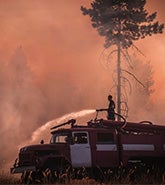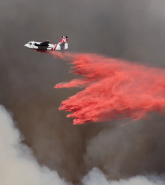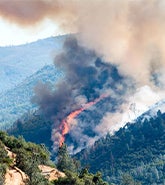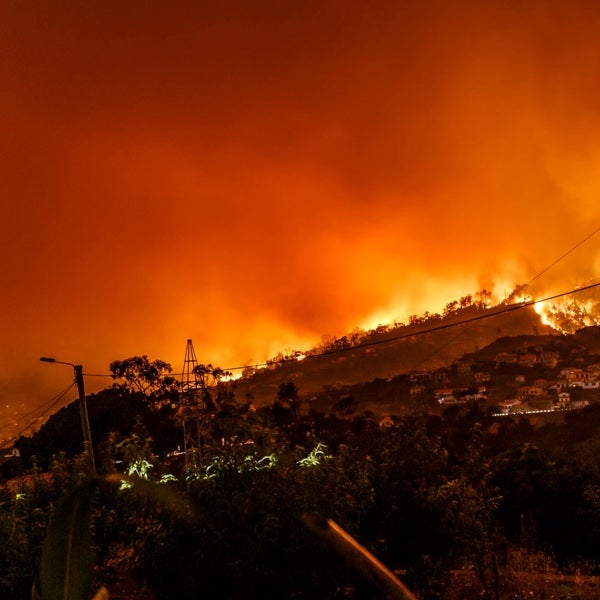Will the Californian city of Paradise ever fully recover from the devastating fire that consumed 95 percent of its houses, now five years ago in November 2018?
In a state that saw a slight overall population decline, Paradise was recently named California’s fastest-growing city. But, as of August 2023, the population of Paradise had reached a third of the 28,000 that lived there in October 2018.
Five hundred new properties were constructed in Paradise last year. At that rate, it would still take thirty years to complete the rebuild, and many former residents surveyed about their intentions have already declared they will not be returning.
Throughout the centuries what condemns a city devastated by catastrophic damage is a spiral of debt as fewer residents generate lower income so that amenities suffer, blight deepens, and more people leave.
Yet every cloud, even one unfortunately billowing with wildfire smoke, may reveal a silver lining. If the fire that destroyed Paradise had been ignited by lightning, there would have been no one to sue.
But it was electrical equipment owned and operated by Pacific Gas and Electric (PG&E) that was acknowledged to have triggered the blaze, and PG&E is one of the largest combined natural gas and electric energy companies in the United States, supplying electricity to 5.5 million customers in northern and central California.
The bankruptcy settlement agreed with PG&E means that money is not going to be a problem, at least for the next few years. The town of Paradise received US$270 million from the PG&E settlement, Butte County another US$252 million, and the Paradise Recreation and Parks District received US$47.5 million.
Now the challenge: how to spend that money on improving amenities to significantly reduce the chance of a repeat catastrophe.
Living in the Forest
The problem is the city’s intrinsic riskiness. Paradise sprawls over 18 square miles (47 square kilometers), and the people who came to live here wanted to live in large lots surrounded by forest, with views of foliage, not their neighbors.
Proximity to trees is also the hazard. The city is not on the edge of the wildlands, like Santa Rosa in California, which experienced the Tubbs Fire in 2017. Paradise is surrounded by, and immersed in, forest. Previous fires have burnt right up to the edge of the settlement.
Half of the city’s 200 miles (322 kilometers) of roads are privately owned, with many only providing access to homes across the mountain ridges: potential death traps in a wildfire evacuation. There is only one road out of town. This sprawl has made it impossible to link house construction with other amenities.
The residents also value their freedom and independence, and have shunned citywide infrastructure projects in the past – the city is notorious for being the largest west of the Mississippi without a sewerage system. The last attempt to fund a city-wide sewerage system was rejected by the city’s voters in 1992.
But there are now plans to use some of the PG&E money to fund a US$233 million sewerage system and construct an 18-mile (29-kilometer) pipeline to carry Paradise sewage westwards down to the pre-existing treatment works in the nearby city of Chico.
Yet the new Sewer Service Area (SSA) will mainly serve land parcels in the city’s urban core focused on three main roads, Skyway, Pearson Road, and Clark Road. No other connections are included in this project. Access to sewerage is being used to encourage housing ‘densification.’ People originally moved to Paradise to be among the trees, and now the council wants them instead to value a sewerage hook-up.
Creating a New City
The Paradise Council would like to create a different kind of city, a city where houses are closely spaced, a city that would be like many others across central California. A city that would be easier to defend in a fire. Yet densification can bring new risks, as seen in the northern suburbs of Santa Rosa in 2017, fires can spread house to house in an urban conflagration.
Meanwhile, much of Paradise has become an informal trailer park, as many residents await further money to rebuild. They look to the PG&E funds to top up insurance compensation for policies that generally underestimated rebuild values, and therefore on their own would not be enough to fund constructing a new property.
As a result of the 2018 fires and the subsequent tree clearance, the land across the city is scarred with a million tree stumps. Left to itself, new shoots will grow, fresh saplings take root, and the forest will return, bringing with it both the amenity of the leaves and the hazard of wildfire.
Buffer Zones
The most ambitious part of the proposals to convince prospective residents that the risk from wildfire has now been tamed is the plan to create five large ‘green belt’ buffer zones around the city, with trees and foliage cleared.
Widely publicized, this plan is more of a pipe dream. The buffer zones would cover 32,000 acres (12,950 hectares), almost all of which is currently privately owned, in 2,200 plots located all around the 18-mile (47-kilometer) city boundary.
Many plots are the former sites of houses destroyed in 2018, awaiting their owner’s intentions to rebuild. Even at a knock-down price of US$2,000 an acre, acquiring the land would cost US$60 million, money that the local Parks and Recreation Department does not have.
The latest published estimate as to how much land has been acquired for buffer zones was from the summer of 2022 when the department announced they had 100 acres, equating to 0.3 percent of the plan. And that is before one costs up the land management that would be required to keep the buffer zones free of vegetative fuel.
It is instructive to compare the actions that follow a catastrophic flood to a catastrophic wildfire. After any disaster, there is a window of opportunity that lasts, perhaps, two to five years, according to the severity of the event, when communities can be convinced to put money aside to fund some action to prevent a repetition.
And then, as the memory fades, it gets harder to argue to fund infrastructure that has no function other than to mitigate a rare catastrophe – there are much more immediate needs: like schools, highways, and fighting crime.
For the response to a flood, this can work quite well – the money becomes available to build a flood defense and once constructed, it requires little maintenance costs and can provide many decades of protection. Compare that with buffer zones and wildfires. The costs for vegetation clearance continue year after year without end until almost inevitably the funding gets cut as people focus on more immediate priorities.
Such wide buffer zones have not been implemented or tested before. The new generation Moody’s RMS high-definition wildfire models are designed to facilitate testing the outcome of the full range of mitigations: individual property vegetation management, fire-resistant construction, hardening electric power networks, and buffer zones.
Embers, carried by a fierce wind, can jump one to two miles before settling on a pile of leaves or a cedar shingle roof to trigger further fires. It is those fires blown by strong winds that evade control and are at the same time those in which the embers will travel the furthest.
The Parks and Recreation Department in Paradise is not prepared to force ‘eminent domain’ to acquire land. So, the best that hope could end up being a patchwork of cleared land and thick undergrowth with little expectation that this would provide any kind of barrier to an advancing firefront.
Yet the buffer zones have captured the imagination. We all have an appetite for good-news stories about curing catastrophes. But we also need to be realistic about how such situations often turn out; underfunded, partially realized, abandoned.
Former residents considering whether to return need proof that the fire risk has been reduced to tolerable levels.
Paradise was always an inexpensive place to live, attracting many older and disabled residents, who did not realize how much they were at risk.
The mean age of the eighty-five who died in the Camp Fire was 72 years, with many forgotten in the early morning evacuation. Paradise’s former hospital closed permanently after the fire, and access to healthcare is paramount – making it difficult for older residents.
History of Fires
The Camp Fire is by no means the first time Paradise has been under threat. In June 2008, 9,300 people had to evacuate southwestern areas of the city when a fire burnt the land between Paradise and Chico. A month later, thousands evacuated the northern side of the city as a fire raged in the neighboring Feather River Canyon.
In August and September 2020, the lightning-triggered 300,000-acre North Complex fire (twice the size of the 2018 Camp Fire) burnt right up to the edge of the Camp Fire burn scar, not proceeding further into Paradise because vegetation clearance had left nothing more to burn. Yet this experience has given some confidence that future fires could also be stopped at the city limits.
Five Years On
How would one summarize a five-year report card on Paradise and wildfire risk? The risk is being successfully reduced. New builds will all have to satisfy more stringent, and more expensive, fire-resistant building codes.
PG&E is hardening its network in and around the town, becoming more rigorous in tree clearance and putting some of the riskiest lines underground. While the buffer zones may not fly, tree clearance within the city’s footprint should be sustained, at least until residents once again prioritize foliage.
The city is not, as one might say ‘out of the woods’ yet. The mayor Greg Bolin has admitted that before the fire the city’s government was ‘barely scraping by.’ Unless it can rebuild its population the city’s finances cannot be sustained once the PG&E settlement has been exhausted.
It is not only the risk but the expense, for the predominately low-income former residents. Within the last year, both State Farm and Allstate have stopped writing new policies in California because of the threat of wildfires.
Homeowners in Paradise must accept higher insurance costs and restricted coverage from the residual market California FAIR Plan schemes. The future climate is likely to be creating more fuel, roasted in longer and hotter fire seasons.
Realistically Paradise will end up with perhaps half, at best two-thirds of its former inhabitants. The town remains on probation. In history, two catastrophes in a decade have been enough to end the prospects for other devastated towns, like the Texan port of Indianola.
The recurrence of a significant fire, in particular, one that destroys newly rebuilt properties, could condemn Paradise to become the first North American climate-change ghost town.
And while Paradise is in the vanguard in confronting the risk, it is by no means alone. In California, an estimated 2.7 million people live in areas zoned as ‘very high wildfire hazard’[1].
[1] Sabalow, R., Reese, P. & Kasler, D 2019










